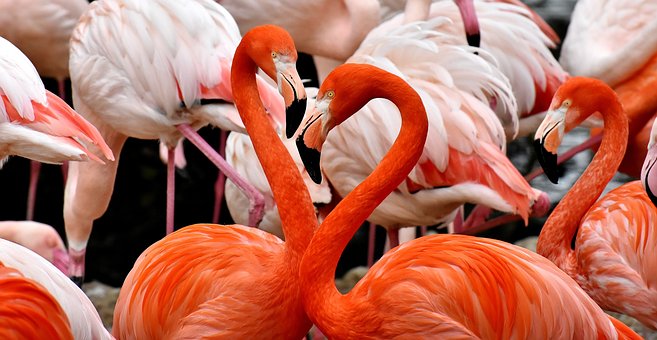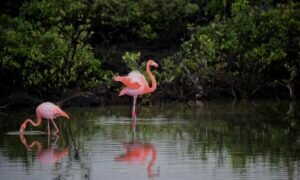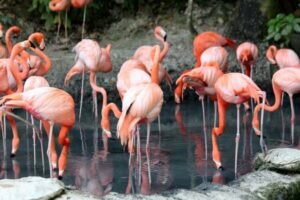Flamingos are striking birds that are pink in colour and have long necks and legs. In terms of avian species, they are the friendliest and most gregarious. There are six different kinds of flamingos, and they frequently flock together. A variety of flamingos, including Caribbean, Andean, James, Chilean, lesser, and greater flamingos, are common sights in many parts of the world. There are four distinct flamingo species found in the Americas. Flamingos found in South America include the Andean and Chilean varieties. You may usually spot both the bigger and lesser species in Africa and even the Middle East on occasion.
Collective adjectives like “flamboyance,” “colony,” and “stand” are probably the most frequent and descriptive ways to refer to a large group of flamingos. Stylish, colourful, bright, dazzling, and flashy are all terms that come to mind when we think of the majestic flamingo, and they all have their roots in the French adjective flamboyant, which originally meant flame. Interestingly, flamingo originates from the Latin word for flame, flamma.
Due to the high amounts of salt in their preferred habitats, flamingos are commonly referred to as a “colony of flamingos,” a collective noun. Thus, the flamingos establish a colony by relocating to a new place and making it their own. The remarkable sight of vast groups of flamingos standing perfectly still, frequently on one leg, is likely where the term “stand of flamingos” came from.
Different names for the Flamingo flocks
Their tendency to form large groups and march in unison, like a regiment of well-trained troops, is the inspiration for another simple collective noun: a “regiment of flamingos.”
One million Lesser Flamingos have been found nesting together, making them the largest flock of birds ever documented by humans. These birds are native to Africa. One can only imagine the mayhem and excitement that ensues when a flock of these birds runs across the surface of a lake and flaps its wings to take flight. Maybe it was because of this show that another term for a large group of birds came into use: a flurry of flamingos.
Even though “a skein of flamingos” isn’t a typical group noun, it is sometimes applied to flocks of birds in flight. Flamingos in flight are more commonly included under the generic word “flock,” which is applicable to the vast majority of avian species.
Do Flamingos Congregate in Large Numbers?
Flamingos need to congregate in large groups to ensure their survival. Coyotes, foxes, eagles, and other birds of prey hunt young flamingos, but adult flamingos are safe from most predators. The baby chicks are safer in these groups because they deter potential predators.
In places with limited nesting options, flocks of flamingos have a better brood success rate than single birds. Flamingo chicks have multiple adults looking out for them. All of the flamingo chicks are safer with the adults watching after them as a group.
Elon Musk Age, Net Worth, Girlfriend, Wife, Family and Biography & More
How Do You Refer to Two Flamingos?
The majority of flamingo pairs seem to remain together throughout the years. These monogamous couples remain together for as long as they are fertile, which can be well over 30 years. Although flamingos typically mate for life, they may switch partners from season to season, especially in large flocks of thousands of birds.
Since flamingos are typically observed in bigger flocks rather than as isolated pairs, no specific term has evolved to describe them. All breeding pairs work cooperatively to construct nests in the same general region.
All flamingos breed at the same time, so they only need to court momentarily to kick off the mating season. In the mud, men and females labour together to construct a nest, though they often prefer to steal a nest already constructed by another pair. While the egg is being incubated, a flamingo will fiercely defend its nest from intruders.
What do you name a bunch of flamingo chicks?
Flamingo babies are called chicks, hatchlings, juveniles, or a “creche of flamingos,” depending on their age. The latter term describes the practice of raising a single chick by a pair of flamingos, who then release the chick into a group where it is watched over by a handful of adults during the day but returns to its parents at night and during feeding times, much like human infants who attend a creche or kindergarten.
Can We Assume That Flamingos Travel Great Distances?
Scientists don’t necessarily regard the seasonal movements of many flamingo populations to be true migrations. Rather, many scientists argue that flamingos are nomadic. Where the birds call home determines the motivation behind their migrations.
If the temperature drops in the winter, flamingos that overwinter in more temperate regions will leave their nests and head south. As a result, they uproot and head for a more temperate region that also has an abundant food source. In places with distinct wet and dry seasons, such as Africa, flamingos travel in pursuit of rainfall.
Some flamingos choose to spend their entire lives in tropical climates where food is abundant. Some of these groups don’t travel far when they leave their home. Flamingos, for instance, in the Caribbean only fly a short distance to Cuba.
When compared to other modern birds, flamingos are the most archaic. They have been traced back to the Eocene period, some 50 million years ago. Additionally, the lifespan of these extraordinary birds exceeds that of all other bird types. A zoo flamingo once survived to be 83 years old, a remarkable feat.
Why do Flamingos group in large numbers?
When it comes to raising their young, flamingos in huge colonies had the best chance of success, proving the adage that “there’s strength in numbers.” There is only ever one egg laid by a breeding female in a given year, and all of the eggs in a given colony are laid at the same time so that the young can hatch and develop together.
Conclusion
The sight of a flock of these stunning birds is quite breathtaking. They typically congregate in very large numbers. These flocking birds share everything from their meals to their sleep to their flight. When they do mate, they often do it as a pair. Although generally peaceful, brightly coloured flamingos can be hostile toward species they find distasteful. Because of this, these birds flock together and cooperate.
Read Also
What is a Group of Quail Called And Why? (Name List)




